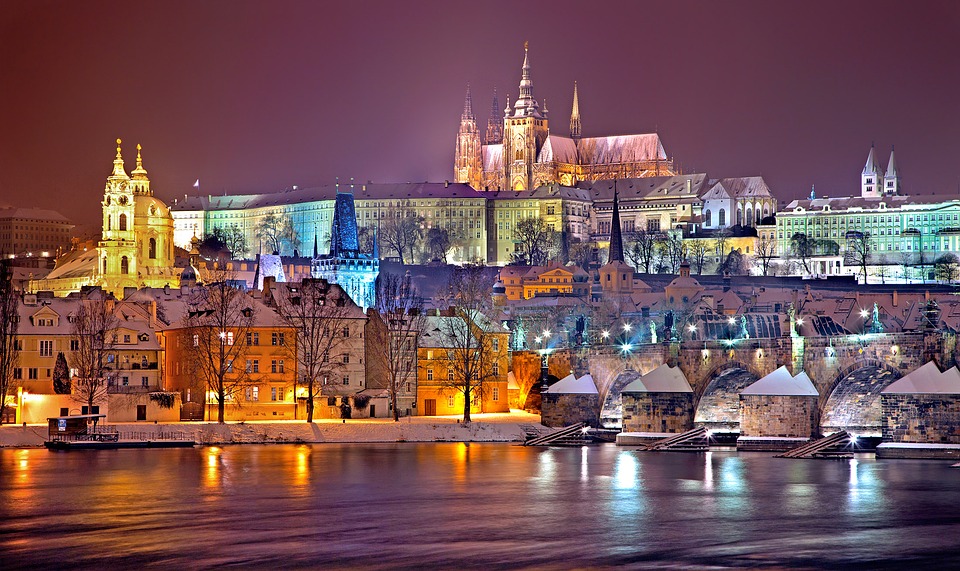
Along with the Charles Bridge, the Castle is a must-see in Prague! Every year, it receives almost 2.5 million visitors (see opening hours here).
- It’s so popular that it’s the most shared castle photo on Instagram in 2021!
- According to the Guinness Book of Records, it’s also the largest ancient castle in the world (almost 7 ha)
I recommend a visit (which I did again recently, more info here or here).
Prague Castle has welcomed kings, emperors and presidents. It sits proudly on the Hradčany hill and offers a magnificent view of the Old Town and Mála Strana. It was probably founded around the year 880 by Prince Bořivoj of Přemysl, and thanks to its long building history, today it features a plethora of architectural styles. When visiting the Castle, don’t miss:
- the Gothic Cathedral of St. Vitus, the country’s most important church
- the Romanesque Basilica of St. George
- Vladislav Hall in the Old Royal Palace, where Gothic and Renaissance meet
- Golden Lane (where Rudolf II, in his quest for the Philosopher’s Stone, is said to have lodged alchemists and scientists, and where Kafka lived at no. 22 in 1917).
- and don’t forget to watch the changing of the guard every hour of the day, with a special mention for noon! The soldiers’ costumes were designed by Theodor Pištěk, who also created the costumes for the film Amadeus.
How do I get to the Castle? This is often the first question you ask yourself once you’ve checked into your hotel (by the way, you can stay nearby, see here). Situated on a hill, the Château can be reached from all sides, north, south, east…
Six routes up to the château, one of them quite secret
I’m going to give you six itineraries. The last one in the article is not well known, but it’s really the nicest on a sunny day. You’ll meet very few tourists there. It’s always where I go when friends come to visit! You can also sleep nearby in one of Prague’s quietest and most romantic hotels, which you’ll remember for a long time: the Romantik Hotel U Raka!
A word of advice: to get the most varied views of the city, don’t take the same itinerary on the outward and return journeys. It’s a pity, for example, to leave the Castle by route 1 or 2 when you can walk down to the river and admire a splendid panorama.
To leave the Château, I recommend route 3!
Route 1: The easiest
The easiest way to get to the Château is to take tram 22, known as the royal or historic tram. You can get on it from Wenceslas Square (Václavské náměstí stop), Národní třída or Malostranská metro station. The tram will drop you off at the Pražský hrad stop, which means Prague Castle. Turn left and in five minutes you’ll be in the second courtyard of the Castle. A classic itinerary with no surprises.
Route 2: The most entertaining
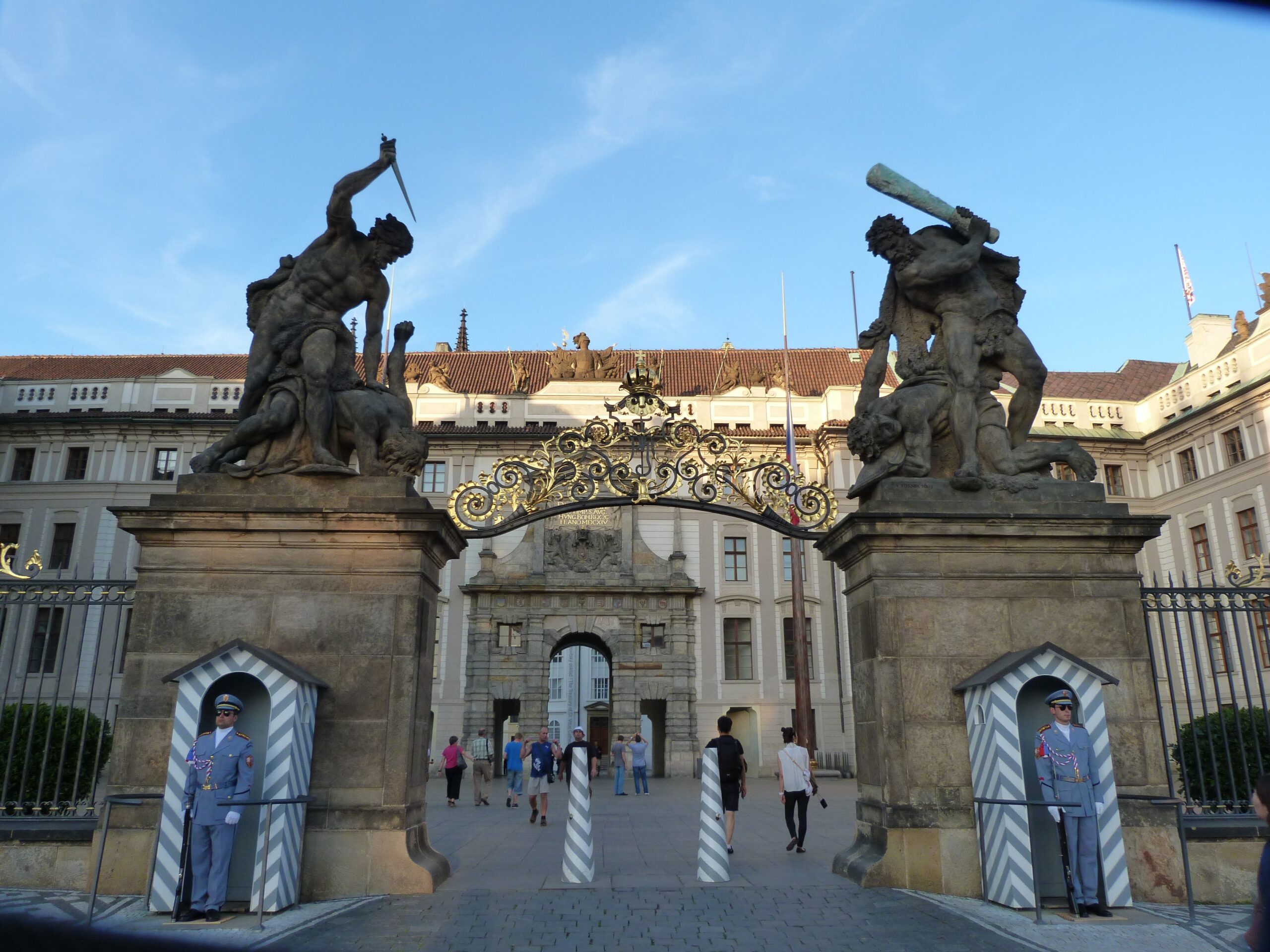
For a long time, this was my itinerary: get off at the Pohořelec station (always tram 22) then follow the street of the same name and 10 minutes later you’re in the main square of the Castle (Hradčanské náměstí). Along the way, you’ll come across a number of nice shops and establishments, such as Rocking Horse Toy Shop (Loretánské náměstí 3), a small store specializing in toys, and the beautiful, authentic U černého vola brewery (At the Black Ox, Loretánské náměstí 1).
Stop in for a Kozel beer among the regulars!
They may be diplomats from the nearby Černín Palace, home to the Ministry of Foreign Affairs. And don’t miss Notre-Dame-de-Lorette, a 17th-century Baroque sanctuary with its Church of the Nativity (Loretánské náměstí 7).
Route no. 3 – The sportiest
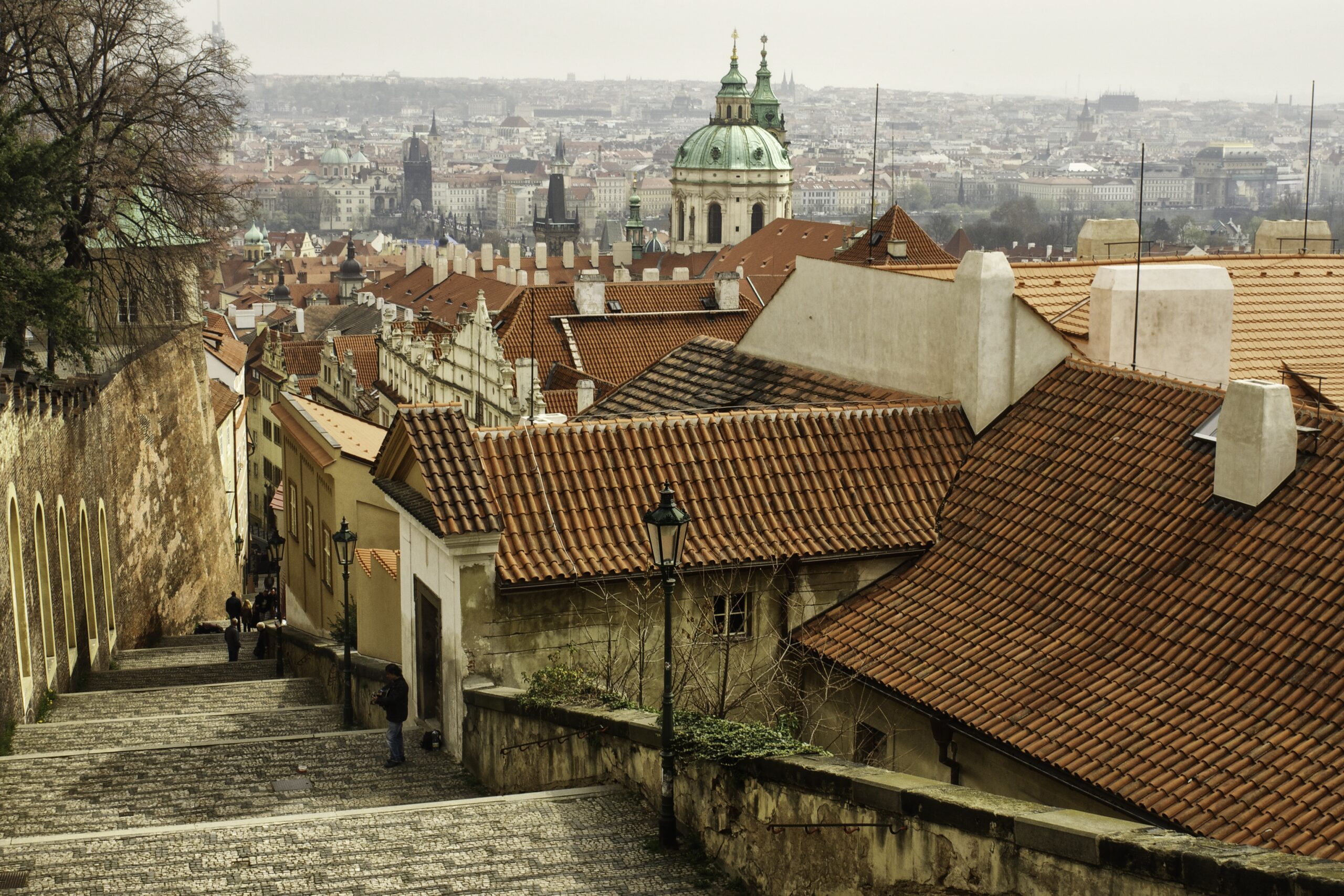
This route will give you a great view of Malá Strana’s rooftops! But it has to be earned, as you start at the bottom of the hill. Start at Malostranské náměstí (where tram 22 also takes you) and walk up the square, where you’ll find vaulted arcades on your right.) Leave St. Nicholas’ Church, which Malostranské Square runs around, on your left, then turn right into tiny Zámecká Street.
Beautiful views of Prague’s rooftops
After about 15 m, turn left into Thunovská Street. You’ve arrived! This street will take you directly to the “New Castle Staircase” (Nové zámecké schody), which in turn will lead you to the main square (Hradčanské náměstí) and the Giant’s Gate preceding the main courtyard. The statues of fighting giants bear the monograms of Maria Theresa and Holy Roman Emperor Joseph II. The sculptures were created by Ignác František Platzer between 1770 and 1771 (the originals were replaced by copies in 1921). Try to arrive for the changing of the guard! The midday change of guard is accompanied by fanfare and trumpets. And it’s not as serious as at Buckingham Palace: you can often catch some of the soldiers smiling..
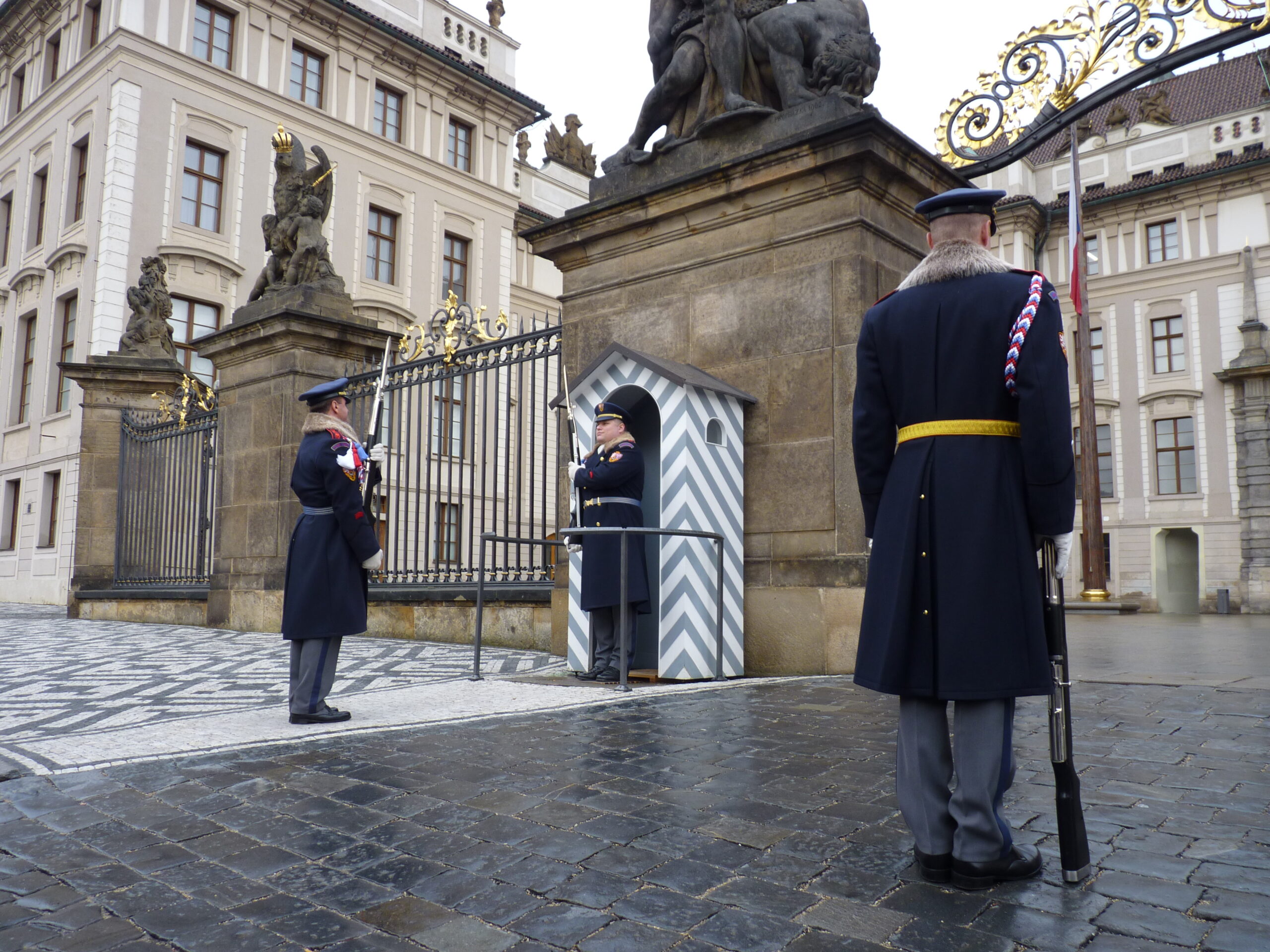
Route no. 4: The most charming
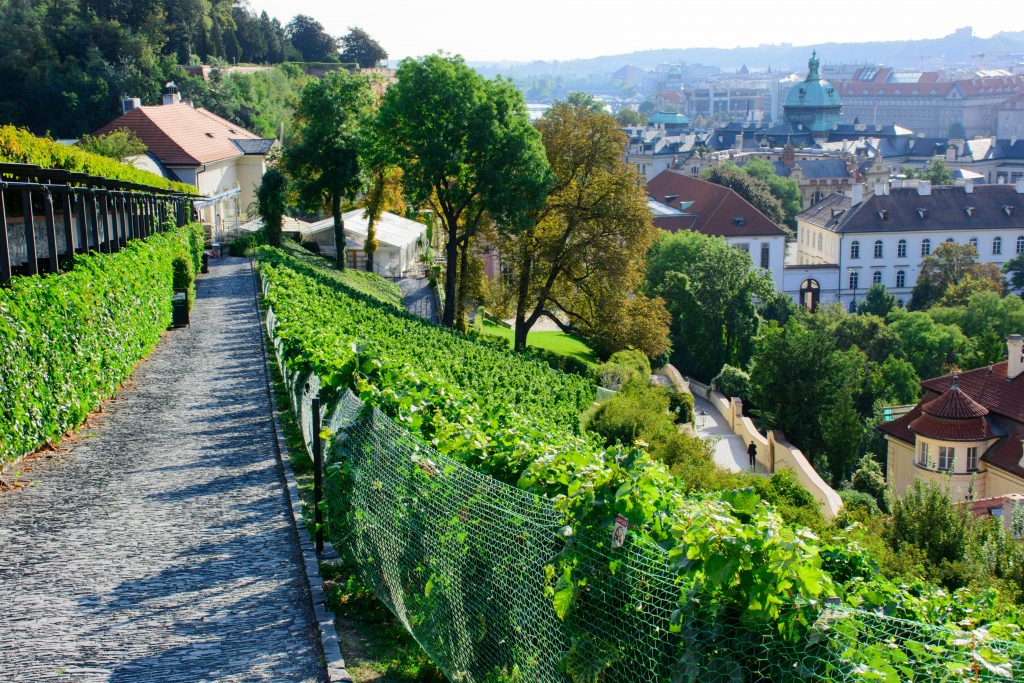
My personal favorite! From Malostranská metro station (line A), follow the streetcar route for a hundred meters or so, then turn left towards the “Old Castle Staircase” (Staré zámecké schody). This is a good route, especially if you’ve chosen to stay at one of the district’s wonderful hotels, such as the MOOo By the Castle. The staircase runs alongside the thousand-year-old vineyard of St. Wenceslas (10th century). You can then stop off in the heart of this small vineyard, at the neo-classical Villa Richter (St. Wenceslas Vineyards). Within a small restaurant complex, you can taste the wine produced here (Riesling and Pinot noir, typical of Moravia and Bohemia). In fine weather, don’t miss the terrace (Pergola Panorama). The panorama is breathtaking all the way up (or down).
A splendid view of the Czech capital
Entrance to the Castle is via the Na Opyši gate. This is also the name of another street leading down to the river, but don’t go through it! Two high walls line it for 250 meters, and it’s mainly used by cars for castle management purposes.
Route no. 5: The most bucolic
This route through the Royal Garden is only available from April to October. To reach the Garden, get off tram 22 at the Královský letohrádek stop, which means Royal Summer Palace. Pass this building, also known as Queen Anne’s Belvedere, a magnificent expression of Renaissance architecture. Stop for a moment to admire the lovely “singing fountain” and continue on into the garden. After a quarter of an hour’s walk, you’ll reach the Château by the Riding School. South of the Royal Garden, you’ll also find the Orangery, a modern building (1999) skilfully blending metal and glass and designed by Czech architect Eva Jiřičná (she also designed the stunning Hotel Josef in the Old Town).
Route 6: The most surprising! (March to mid-November)

Once you’ve got off at Pohořelec (tram 22), a variation on itinerary 2 takes you to Loretánské náměstí (Loreto Square). Pass the Ministry of Foreign Affairs (Palais Černín) and Notre-Dame-de-Lorette, then take Rue Černínská down to the left in front of the gardens of Palais Černín before taking the first right and street Nový Svět (New World). Mind you, this is perhaps Prague’s nicest street! Its charming little houses now cost a fortune, although originally they housed Castle workers… At the end of this charming street, turn left into U Brusnice and very soon on your right you’ll find the entrance to a path called the Deer Moat or Stag Moat (Jelení příkop). It’s a small natural ravine (reopened in 2023 after four years of renovation) very close to the Castle and where there’s nobody! It’s so called because in Rudolf II’ s time it was a natural hunting reserve. Until the 18th century, deer roamed this valley of the Brusnice stream, while during the First Republic, it was home to bears that Czechoslovak legionnaires in Russia had offered to President T. G. Masaryk.
The guidebooks don’t mention it, and few Czechs know about it
After descending a few steps, at the end of a small clearing is a superb 80 m-long pedestrian tunnel linking the lower and upper parts of the moat protecting the castle on the north side. The tunnel was built in 2007 by architect Josef Pleskot and commissioned by former president Havel in 2002 (who reopened the moat, which had been inaccessible under Communism, to the public). Note the small heart on the commemorative plaque at the entrance, which Havel used as his signature… Once out of the tunnel, take the beautiful little zig-zag path on your left, marked by large horizontal wooden beams. At the top, on your left, a bridge leads to the Château’s second courtyard. Follow this route and you won’t regret it! Today, visitors can also come from Klárov along Chotkova Street to the lower stag moat (there are footbridges from Klárov and from Jelení Street). The route continues along the Brusnice River to the Poudrière bridge embankment. The Goat Trail links the lower part of the Deer Moat with the Royal Garden (near Stájový dvůr).
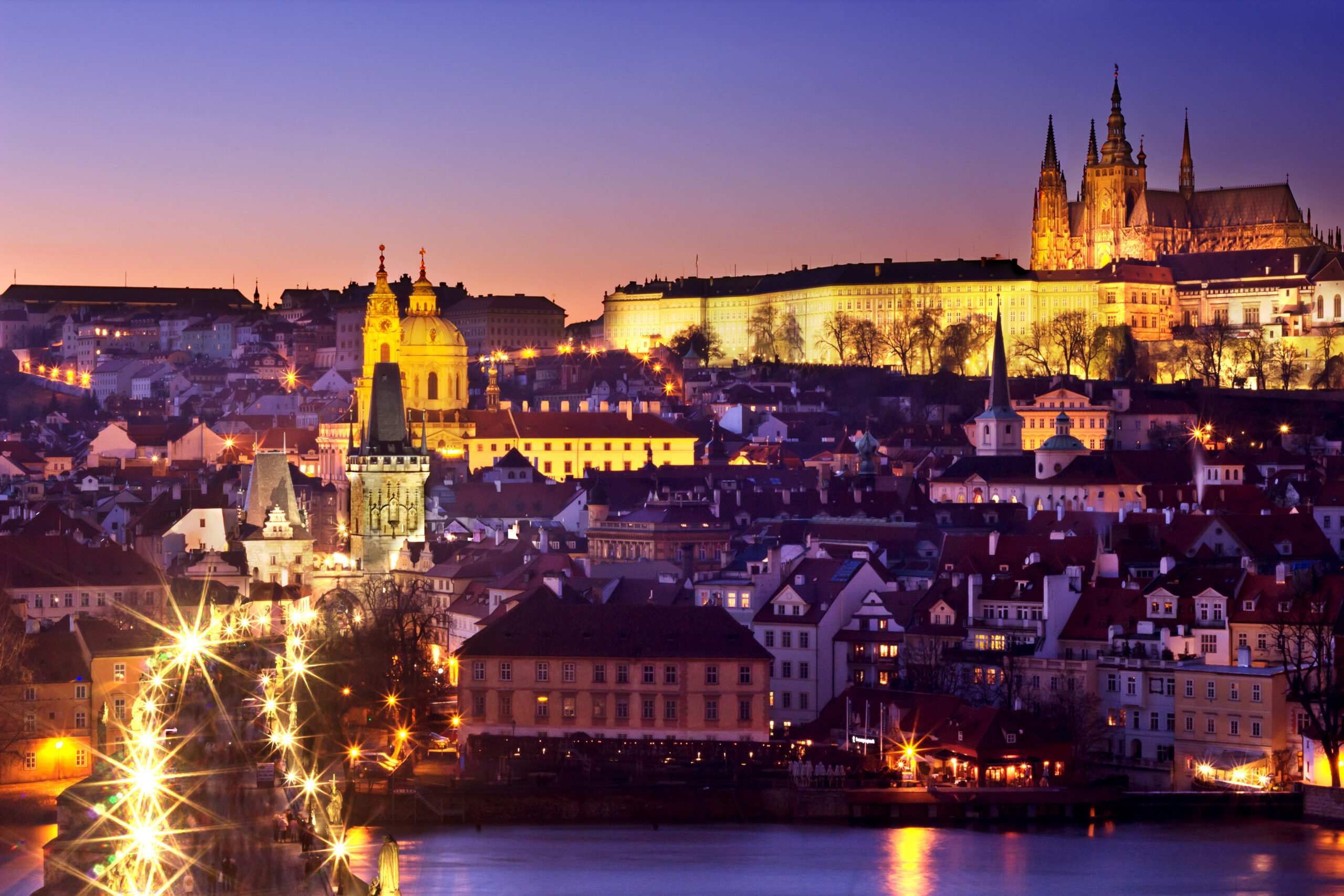
To conclude, here’s a useful link to the Chateau’s website, which reproduces some of these and other itineraries with precious little maps. And to stay close to the Castle, you have the fantastic Hotel U Raka already mentioned above and perhaps the quietest and most bucolic in town! A hotel near the Castle means you can easily discover it early in the morning or in the evening when all the tourists have left. You can also easily reach the city center on foot via the Charles Bridge, or by public transport and the famous tram 22 mentioned throughout this article!